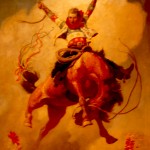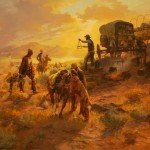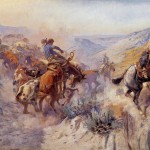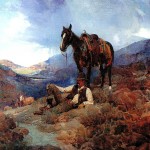Jackson Hole sits on a high valley surrounded by the Teton Range within the Rocky Mountains. Prior to the 1800’s, the Shoshoni, Crow, Blackfeet, Bannock, and Gros Ventre Indians used the area in summers to hunt buffalo, mule deer, antelope and elk. Mountain men and trappers from Canada and the US followed the Native American trails, and entered the region to hunt beaver for pelts, until the bottom fell out of the beaver fur market in 1845 when silk for hats became the new vogue. A lull fell over the valley for a few years. One or two isolated trappers and their Native American wives made homes there and Indians returned to hunt in summers. The first settlers came in the 1890’s. Finding the land too poor to grow crops, the homesteaders turned to cattle ranching to make a living. Wherever ranches, cowboys and horses dwelled, rodeos soon followed. Around 1912, the Jackson Hole Rodeo opened, with dude ranches ensuing several years latter; both have been going strong ever since.
My husband and I pulled into Jackson Hole on our wandering journey through the American West. Tourism had a strong hold on the town and there were countless things to do and see. The rodeo began at 8 pm; we bought tickets, and climbed into the grandstands to wait for the show to start. The arena was small as rodeos go, which gave everyone a ringside seat, up close and personal.
The first bronco leapt out of the chute flying into the air bucking and spinning, the sound of his hoofs pounding the hard earth like drumbeats. The cowboy on the horse’s back held tight. His hat sailed aloft as the defiant steed kicked and twisted; it wasn’t long before the cowboy’s backside hit the dirt. We could see through railings a row of cowboys lined up on the other side of the arena, crowded around the back of the chute, waiting their turn to try the next horse. Some of the men smiled, most were intent on the event which they were signed up to participate in. They wore cowboy hats, jeans with chaps, button snap shirts and leather boots with intricate, hand tooled designs. The scheduled events, barrel racing, calf roping, bronco and bull riding proceeded until the last rider finished and winners were announced through the loudspeaker, all in the spirit of control, conquest and victory over the rebellious animals.
The crowd dispersed into the warm, summer night, cars pulled out of the parking lot and everyone headed home. We stopped our car at a dirt lot at the edge of town, not far from the rodeo arena. The black sky embraced the Milky Way, constellations and a thin crescent moon. A few days before we purchased fireworks at a roadside stand, and this seemed like a good place to set them off. Moe ignited a cone shaped fountain which lifted a spray of sparks several feet into the sky only to cascade down in a steady stream of silver and gold. He placed a few bottle rockets in a glass jar and lit the fuse. The fireworks sped upward, higher and higher and exploded adding colorful artificial stars temporarily to the sky over our heads. It seemed like a fitting end to a wild, west show and a cowboy kind of day.
A few decades slipped by, and I found myself in the company of Mary Mix at the Rockwell Museum of Western Art in Corning, NY. We stood in the Cowboy Gallery before an exhibit displaying works by several famous Western artists. Charlie Russell, Charlie Dye, and Harry Jackson, cowboys turned artist in an attempt to capture the drama and beauty they observed on the open range, and Frank Tenney Johnson, William H. Dunton and N.C Wyeth, visitors to the west painting scenes they witnessed. Two splendid rodeo pictures hung depicting broncobusters that could have represented the events I observed at the Jackson Hole Rodeo years ago. We talked about Indians, cowboys, Western history and artists.
“The Western cowboy and cattle drives arose after the civil war with the need to move cattle from ranches to railheads where the animals were shipped to market,” said Mary.
“The Civil War marked a changing point for many things,” I replied.
The image of the American cowboy on his horse, easily visualized and represented in hundreds of books, articles, films and works of art has been indelibly stamped on the American psyche. The cowboy arose from the need to move cattle by trail from the open range in Texas, western Kansas, Nebraska, Colorado, Wyoming, Montana and the Dakotas to railheads where the animals were shipped to slaughter and packing houses in the East. The long, slow movement of cattle created a new culture dependent on skilled horsemen. The average cattle drive took 2 months and consisted of 3,000 cattle, 10 cowboys with 3 horses each, a horse wrangler, and a cook with his chuck wagon. Cowboys were primarily young single men from a variety of ethnic backgrounds; Anglo-American, Mexican, Afro-American, and Native American. They worked and protected cattle on ranches and were not involved in the American Indian Wars which were fought by the US military.
“I give school tours through the museum and often stop at a painting like this one by Charlie Dye. I ask the students to take a close look at the painting. What is the artist trying to communicate through his work?” Mary said turning to the painting of a chuck wagon, cook and cowboys at the end of the day on the open range entitled “Come and Get It”.
“It seems that American Western Art concentrates on the actual story of the West in contrast to Modern Art and other contemporary art forms which focus on an abstract psychological impression of the world around us,” I said.
“Perhaps that is why visitors to the Rockwell Museum have an easier time relating to the artwork. No matter what your background the paintings have something to say to the viewer,” said Mary.
Charlie Dye (1906-1973) was born in Canon, Colorado and began working on cattle ranches as a young boy. By his twenties, he was employed on ranches in Colorado, Calfornia and Oregon. He carried a sketchpad and pencil with him recording the scenes he saw as he worked as a cowhand. At 23 he sustained an injury after being thrown from a horse and while recuperating in the hospital viewed the artwork of the famous cowboy artist Charlie Russell. Russell’s artwork inspired Dye to pursue art as a profession, against his father’s wishes. He left ranch life and attended the Chicago Art Institute and the American Academy of Art. Upon finishing, he moved to New York City and set up a freelance art studio entering the art world as an illustrator. He created magazine covers and artwork for stories in a wide variety of magazines: Adventure, Walt Colburn’s Western, Argosy, Coronet, American Weekly, Saga, Outdoor Life, and the Saturday Evening Post. By the 1960’s, classic illustration came to an end. Dye left the East and moved westward to Seona, Arizona where he setup a studio. He devoted the rest of his life to painting the scenes that first inspired him to become an artist, and in 1965 helped establish Cowboy Artists of America.
Charlie Dye has been quoted to have said,
“Today we can make a living painting. I don’t mean little squirty things, but real work being sold through big galleries. People are buying this stuff because they maybe feel the era of the cowboy is just about on its last legs. People are groping for something that is not so damned mechanical or artificial as life has become. There is no ‘ism’ tied to the tail of my painting. Maybe it doesn’t stack up to much with the Metropolitan Museum in New York, but there is one helluva lot of people buying it in small towns. It doesn’t bother me not to be in a big museum. I don’t paint for the honor of it. I do it because I like to paint and I like to eat! Those that buy my works are cow people and others that believe old Mother Nature knew her oats when she made the West and her finest animal, the horse.”
It might surprise Charlie Dye that his paintings are hung in 13 American museums and will be enjoyed for a long time to come. Mary and I turned our attention to the center of the Cowboy Gallery where a bronze sculpture by Harry Jackson sat in a showcase depicting a Pony Express rider, armed with a six-shooter astride a galloping horse.
“Most people don’t realize that the Pony Express only lasted 18 ½ months. The route stretched from St. Joseph Missouri to Sacramento, California. At the time, the Pony Express was the fastest way to move the mail. The average rider was 16 or 17 and of small stature. The mail was more important than the rider who rode 80 to 100 miles at a time switching horses every 10 miles at stations along the way before a new rider took up the trail. It just took 10 days in summer and 16 days in winter to complete the run, until they went bankrupt and became part of the mythology of the west,” said Mary.
“Wow, that’s fast especially considering the terrain and weather,” I replied.
The threat of the Civil War created a governmental demand for fast communications with California to keep the state in the Union. On April 3, 1860, the Pony Express was created by a private company to deliver mail to the West Coast with the hope of obtaining a federal mail contract. The news of the early war was carried in saddlebags across the dangerous western route through a system of relay riders. Even though, riders and horses endured great hardship and peril, in the history of the Pony Express only one mailbag was lost and one rider died. At the company’s peak there were more than 100 transfer stations, 80 riders and between 400 and 500 horses. The Pony Express never received a federal contract to deliver the mail, and when the Pacific Telegraph line was completed in 1861 the company entered bankruptcy; however, the bravery and courage of the riders and their fast horses captured the heart of the nation.
For the Pony Express Centennial in 1960, a reenactment was held crossing multiple states and enlisting hundreds of riders. For a two day period, riders re-ran the Pony Express route in both directions, as towns along the way celebrated with festivals, parades and rodeos. In Salt Lake City monuments and plaques were dedicated to preserve the location of the old trail and to remember the brave riders of the Pony Express.
I thanked Mary and walked out of the museum, into the grey winter afternoon, crossed the street and stopped in the parking lot. I turned and glanced back at the huge brick building housing the Rockwell collection of Western Art and thought how lucky we are to have such a beautiful museum in our area, filled with vibrant history and artwork of the American West. Next time you’re in Corning stop by and see the museum for yourself. You’ll be glad you did.
Note: This concludes my 3 blog series on the Rockwell Museum of Western Art. I thoroughly enjoyed visiting the museum and writing the articles. I hope you enjoyed reading them. I also want to wish Mary Mix the best and a special thanks for all of her valuable help. Happy trails to everyone – Pat
Sources:
http://en.wikipedia.org/wiki/Grand_Teton_National_Park, http://www.jacksonholerodeo.us/, http://www.jacksonholechamber.com/jackson_hole_wyoming/jacksons-history.php, http://en.wikipedia.org/wiki/Cattle_drives_in_the_United_States, http://en.wikipedia.org/wiki/Cowboy, http://www.cliffsnotes.com/study_guide/The-Cattle-Kingdom.topicArticleId-25238,articleId-25174.html, http://cowboyartistsofamerica.com/history/history_two.html
www.askart.com/AskART/artists/search/Search_Grid.aspx?searchtype=MUSEUMS&artist=5867, http://www.pulpartists.com/Dye.html, http://www.so-calleddollars.com/Events/Pony_Express_Centennial.html, http://www.xphomestation.com/index.html
The American West, People, Places, and Ideas by Suzan Campbell with an essay by Kathleen E. Ash-Milby
Artwork credits: “Bronco Rider” by NC Wyeth, “Untitled” by William H. Dunton, “Come and Get It” by Charles Dye, “The Mix Up” by Charles Russell, “Morning Showers” and “Branding” by Frank Tenney Johnson.







Cara Mia,
Your blog is at its one year anniversary and I have enjoyed every entry. I look back with fond memory on our western travel and our stop at Jackson Hole. I remember well the rodeo followed by romantic fireworks in the evening.
I look foward with eager anticipation to the coming year’s blog posts. So lets mount up, ride out amd remember to never squat on our spurs!
Your ever loving Huckleberry, Moe